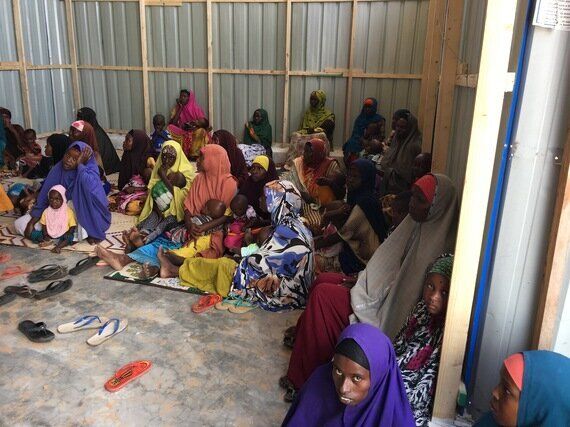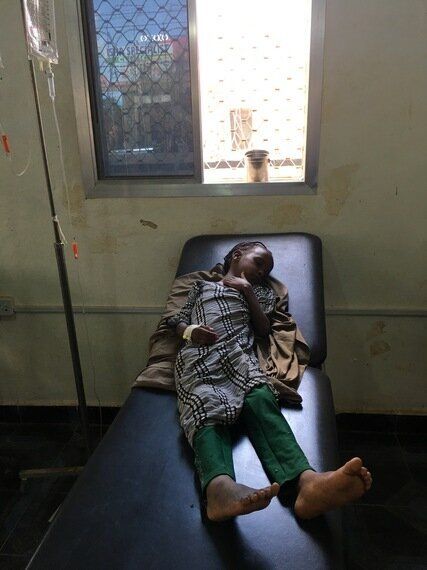The first to die was pretty little Isse Salat, eight. She was followed by her siblings Noor, 12, Sangabo, nine and Alio, just five. Their parents endured the unimaginable ordeal of seeing all four children dehydrated and destroyed by cholera in the space of four days.
"The only medicine I had for them was anti-worm tablets," whispered their father, Mohamed, his face gaunt with grief. "There was nothing I could do at any stage. It was their destiny but it was terrible for us."
Mohamed and his wife, who were 30km from a clinic but had no way of getting there, resolved to save their four surviving children, aged nine to 18, from a similar fate. They walked 80km in seven days to Baidoa, Somalia's second city, where they now occupy a tent within yards of a clinic run by Save the Children.
Thousands of people driven from their homes by the worst drought in living memory are arriving in Baidoa every day. Old men, pregnant teenagers and couples who have carried small children 100km or more are descending on bleak stretches of stony wasteland on the outskirts of the city.
More than 150,000 in all have abandoned villages that have run out of food and made the perilous journey to the city, only to find that there is not enough water for them there. The only shelter they have been offered from the near-40C heat is a few sheets of plastic held up by sticks.
Many of these patient, dignified people have buried loved ones who succumbed to cholera or starvation at home. Some have watched malnourished toddlers perish en route, and had to dig their graves by the roadside.

Somali families fleeing drought and malnutrition in rural areas converge on this IDP camp and clinic in Mogadishu, Somalia
(Photo credit: Sean Ryan/Save the Children)
Across Somalia, the country worst affected by the Horn of Africa's escalating food crisis, more than half a million people are on the move in epic scenes that show not only the desperate urgency of fundraising appeals but also, sadly, the limits of the aid agencies' reach.
Hassan Noor Saadi, Save the Children's director in Somalia, estimates that 200,000 lives will be saved by the generosity of donors ranging from the UK's Department for International Development, which pledged £110million for the country, to schoolchildren who raised a few pounds for last month's £50million Disasters Emergency Committee appeal for East Africa.
However, more than 60,000 starving people may yet die, Saadi believes, mainly in villages to which western charities and the United Nations have little or no access. This is because the rural areas are largely controlled by the Islamic militant group, Al-Shabaab.
As the cholera spreads, claiming far more lives than official figures suggest, and spiralling deaths from starvation prompt warnings of a full-scale famine within two months, President Mohamed Abdullah Mohamed has warned Al-Shabaab to lay down its weapons in 60 days or face 'war'.
The newly elected president, who wrote a thesis on 'US strategic interest in Somalia' for his master's in political science at the University of Buffalo, is reflecting the muscular military stance of Donald Trump, but the timing of his statement has caused concern among aid agencies.
Saadi, of Save the Children, said: "We are on the brink of a massive catastrophe in Somalia, with the death of three-quarters of the livestock, a rapid increase of children suffering extreme malnutrition and the depletion of water stories in dozens of communities."
The 'catastrophe' is summed up by the poignant story of Adnan Muktar, a softly spoken, 36-year-old farmer. When drought killed his three cattle he decided the best chance for his family lay in a 90km journey to Baidoa by donkey and cart. But the donkey died and the family's water soon ran out. Adnan watched the life drain from his two-year-old; then, five days later, from a second child, aged three.
"I buried them by the side of the road," he said, flinching at the memory.
His wife Fiday, 24, who was eight months pregnant, somehow walked to the camp just in time to give birth last week. The couple are left with three other children as well as the new baby. "It is God's will," Adam said.
One of the deadly consequences of the exodus from the countryside has been a steady stream of new cholera cases in Baidoa. Of 1,800 people carried into Save the Children's cholera treatment centre since it was set up in February, 19 have died. Almost all came from outside the city and arrived too late to be saved. Two children - one of them under five - were dead before they could even be examined.
Last week, the lucky ones were lying on canvas 'cholera beds', groaning wide-eyed at parents who fanned them with cardboard as drips delivered the fluids and antibiotics they needed. Mobile health teams have saved another 750.
The doctors stress that cholera can kill within hours of the first signs of vomiting and diarrhoea. It is especially lethal in children who are malnourished - and the numbers identified with 'severe acute malnutrition' are rocketing at Bay Regional Hospital in Baidoa.
Among them is five-year-old Hakima Lam, who weighed only 8.3kg when she arrived. Her mother, Fardosa, who already has three children at the age of 18, has seen her gain 3kg but she still looks emaciated and her eyesight may have been permanently damaged by measles.
Cholera also appears to be taking hold in Mogor and Manyo camp, one of 155 for displaced people dotted around the city. Here, 7,000 souls have arrived in a month. The UN is delivering water, but only enough for half of them. They are crammed into stifling little makeshift tents with nothing to eat. There are no latrines. The first suspected cases of the disease are already being reported.
Even the rains due this month will provide little immediate relief. Crops will take months to grow, cows will take up to a year to produce milk and human waste contaminating water supplies will give the cholera precisely the conditions it needs to thrive.

Families fleeing drought and malnutrition have set up improvised IDP camps in Baidoa, Somalia
(Photo credit: Sean Ryan/Save the Children)
More than two million are thought to be beyond western help in Al-Shabaab territory. Nobody is counting the bodies in these rural areas, but the number of cholera victims is thought to be several times higher than the official toll of around 500, and the signs are that the deaths linked to malnutrition are rising fast.
Thirty people gathered around an aid official at Mogor and Manyo camp, including a heavily pregnant woman who had not eaten for three days. When they were asked who had lost a member of their family, every hand shot up.
To make a donation to Save the Children's East Africa appeal please click here.
*All children's names have been changed to protect their identity.

A girl receives treatment for malnutrition at Bay Regional Hospital, Baidoa, Somalia
(Photo credit: Sean Ryan/Save the Children)